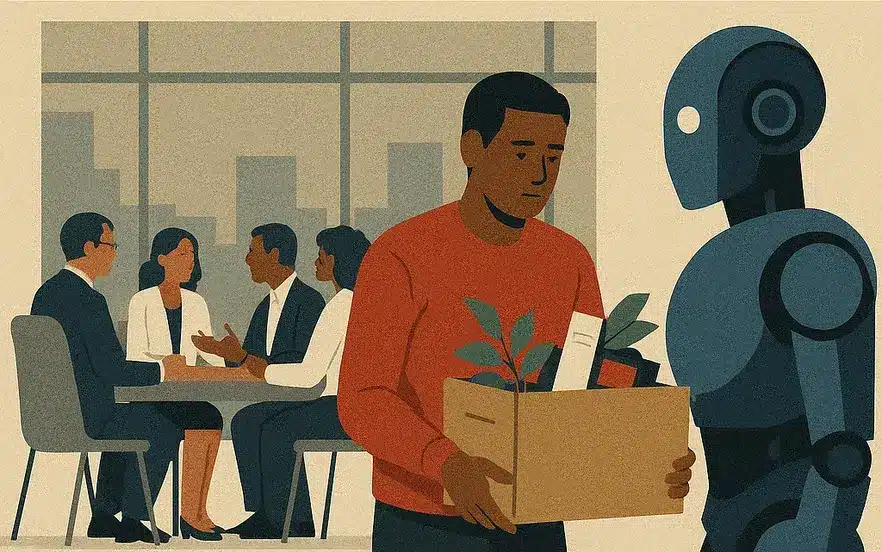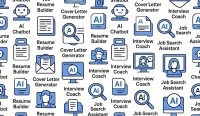Amazon is set to announce massive layoffs—as many as 30,000 corporate job cuts—marking the largest layoffs in the company’s history according to Reuters and CNBC. The pink slips will reportedly begin going out tomorrow, targeting white-collar corporate office positions. Amazon has not officially commented on these reports, but the implications are enormous for a company of Amazon’s size and influence.
The cuts will hit advertising, HR, and cloud divisions—the white-collar heart of Amazon’s operations. If these 30,000 layoffs are confirmed, they represent approximately 10% of Amazon’s corporate office jobs, demonstrating the scale of this restructuring effort.
AI as the Holy Grail for Cost Cutting
What these reports reveal is that artificial intelligence has become the holy grail for big companies seeking cost reductions. Amazon plans to use AI to eliminate layers in the office structure, make remaining employees more productive, and move work to AI functions that previously required human staff.
This goes beyond the typical tech company layoffs we’ve seen during economic downturns. Amazon grew dramatically during the pandemic, adding thousands of workers to meet explosive demand. Then in 2022, the company realized it had hired too many people and cut 27,000 jobs during a massive downsizing. This new round of layoffs—potentially even larger at 30,000—comes on top of those previous cuts.
Andy Jassy’s Commitment to Cost Cutting
The rationale behind these cuts comes directly from the CEO’s office. In a memo to employees this past June, Andy Jassy explicitly stated that Amazon would do everything possible and use any technology available to cut costs. This directive translated into identifying positions where AI could replace human workers, particularly in corporate functions like advertising, human resources, and cloud operations.
Jassy’s commitment wasn’t aspirational—it was operational. The directive to use technology, including AI, for cost reduction has now manifested in the largest job cuts in Amazon’s history. This represents a fundamental shift in how tech giants view their workforce: employees are increasingly seen as costs to optimize rather than assets to develop.
The White-Collar Bloodbath
These aren’t warehouse workers or delivery drivers being cut—those jobs remain safe for now. Instead, Amazon is targeting the highly skilled corporate workforce that traditionally enjoyed job security in the tech sector. Advertising professionals, HR specialists, and cloud division employees are discovering that their positions can be automated through artificial intelligence.
The cuts span critical business functions. Advertising departments that help Amazon generate revenue through sponsored products and display ads. Human resources teams that recruit, train, and manage the workforce. Cloud operations that drive Amazon Web Services—the company’s most profitable division.
This targeting of white-collar jobs represents a new phase in automation. Historically, automation threatened blue-collar manufacturing positions. Then it impacted retail and service workers. Now artificial intelligence is eliminating the corporate office jobs that educated professionals once viewed as safe.
The Automation of White-Collar Work
Automation has moved beyond factories and retail floors — it’s entering the boardroom. Artificial intelligence is now reshaping corporate roles once considered untouchable, from analysts to marketers to administrators. The future of work won’t be defined by who’s replaced, but by who adapts fastest to technology-driven change.
Explore AI & Workforce Transformation Roles →AI Taking Over Corporate Functions
Amazon is using AI to analyze its organization and identify redundancies and inefficiencies. This isn’t about simple cost-cutting measures like reducing travel budgets or freezing hiring. Instead, Amazon is fundamentally restructuring its corporate structure, discovering that AI can handle work that previously required human judgment and expertise.
The company has the technology capability through AWS to provide AI services to customers. But now it’s using that same AI technology internally to eliminate its own corporate jobs. This represents using AI for both product development—creating AWS AI services—and internal cost cutting—replacing human workers with AI functions.
The Pandemic Hiring Hangover
Amazon experienced explosive growth during the pandemic as millions of people shifted to online shopping. The company hired aggressively to meet demand, expanding its workforce dramatically. However, as pandemic-era demand patterns normalized and economic conditions shifted, Amazon discovered it had over-hired during the boom years.
The 2022 layoffs of 27,000 workers were Amazon’s attempt to correct that over-hiring. But these reported 30,000 additional cuts suggest the correction wasn’t sufficient. The company is now going beyond merely correcting pandemic-era hiring mistakes and instead using AI to permanently reshape its workforce structure.
What This Means for Other Tech Companies
When Amazon announces cuts this large, it signals trends for the entire tech industry. Other big companies watch how Amazon manages this transition and will likely follow similar strategies. The holy grail of using AI for cost cutting isn’t unique to Amazon—it’s becoming standard practice across the sector.
The implication is that corporate white-collar jobs across tech companies face similar risk. If Amazon can cut 30,000 corporate jobs using AI, other tech giants can and will do the same. Advertising, HR, finance, operations—any corporate function where AI can improve efficiency or replace human workers becomes vulnerable.
The Cloud Division’s Contradiction
Interestingly, Amazon is cutting jobs in its cloud division even as AWS remains the company’s most profitable segment and driver of growth. This suggests that even highly profitable divisions face efficiency pressures. If AI can make cloud operations more efficient with fewer people, those people become expendable regardless of division profitability.
This creates an internal contradiction: Amazon develops AI cloud services for customers to grow their businesses, while simultaneously using AI to shrink its own workforce. The cloud division isn’t immune from these cuts even though it generates substantial revenue and represents Amazon’s future.
A Fundamental Business Shift
These layoffs signal a fundamental shift in how Amazon views its workforce and operations. The company is no longer focused solely on growth and expansion—it’s now equally focused on efficiency and optimization. Using AI to eliminate corporate layers isn’t a short-term cost-cutting measure; it’s a long-term strategic shift toward a leaner, more automated organization.
Andy Jassy’s directive to use any technology available for cost cutting wasn’t empty words. It was a roadmap for Amazon’s future, where AI increasingly handles corporate functions that once required human employees. This 30,000-job cut represents the largest manifestation of that strategy so far, but it likely won’t be the last.
Broader Economic Implications
When a company the size of Amazon cuts 30,000 jobs, the ripple effects extend beyond the tech industry. These are high-skilled, well-paying positions being eliminated, representing millions in lost wages and reduced consumer spending. The economic impact spreads through communities where these workers live and spend money.
The message to other corporations is clear: AI can now replace substantial portions of the white-collar workforce. Companies will identify functions where AI improves efficiency or replaces human workers, then cut those jobs. This isn’t limited to Amazon—it’s coming across corporate America.
Frequently Asked Questions
Q: How many jobs is Amazon cutting?
A: Amazon reportedly plans to cut 30,000 corporate jobs—the largest layoffs in company history, representing approximately 10% of the company’s corporate office workforce across advertising, HR, and cloud divisions.
Q: Why is Amazon cutting jobs now?
A: CEO Andy Jassy committed in a June memo to using any technology, including AI, to cut costs. Amazon is using AI to identify and eliminate redundant layers and replace human workers with automated functions.
Q: What departments are being hit by these layoffs?
A: The cuts target white-collar corporate jobs in advertising, human resources, and cloud divisions—core business functions where AI can replace human employees or eliminate entire organizational layers.
Q: Is this related to AI automation?
A: Yes. Amazon is using AI to analyze its organization, eliminate layers, improve productivity, and move work to AI functions. The company views AI as the holy grail for cost cutting while maintaining operational capacity.
Q: How does this compare to Amazon’s previous layoffs?
A: Amazon cut 27,000 jobs in 2022 during a post-pandemic downsizing. These reported cuts of 30,000 jobs are even larger and come on top of those previous reductions, targeting white-collar corporate positions rather than operational workers.
Q: What does this mean for other tech companies?
A: Amazon’s massive AI-driven layoffs signal a trend across the tech industry where corporate white-collar jobs become vulnerable to AI replacement. Other companies will likely follow similar cost-cutting strategies using artificial intelligence.




